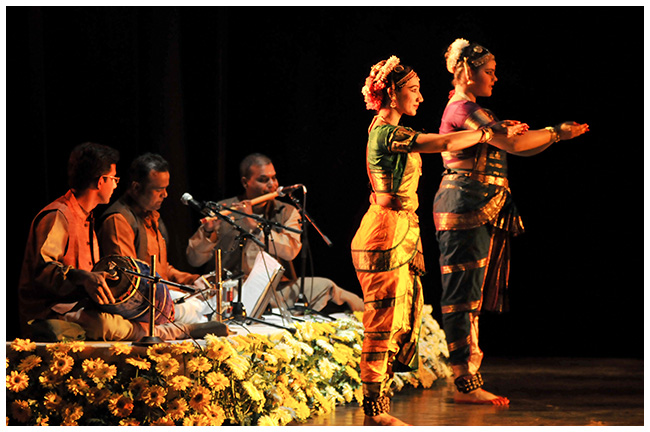
Although there can be music without dancing, there can be no dancing without musical accompaniment. Music therefore is undoubtedly an integral part of dancing. Aside from the vocal support rendered to a dancer, the other musical instruments widely used in Bharatnatyam are the cymbals, violin, veena, flute, tanpura and mridangam.
As we all know that the nritta part of any dance performance is set to a particular talam or beat or time cycle. To establish this, the cymbal is used by the nattuvanaar. Also, when adavus, jatis or complicated teermanams are performed, the cymbal gives support and auditory influence to the dancer as well as the audience in order to emphasize the beauty of the choreography of the pieces. As the cymbal is used by the nattuvanaar, it also lends support to the entire orchestra to maintain a homogenous rhythm in the talam.
The mridangam also follows as the cymbal the movements of the dancer, especially of the feet in a nritta sequence, primarily to establish with clarity the execution of the jatis. It also gives special emphasis to certain moods in an abhinaya sequence. For example a quick and loud drumming to show rage, soft drumming to show knocking on the door etc.
In musical pieces for dance, provision is always made for interpolations of jatis, korvais, and theermanams. But here too, merely playing the mridangam or striking the talam according to the footwork is not the only technique. Usually, flourishes and embellishments are added and given by the mridangist and nattuvan. It is also important that they do not overshadow the entire effect of the recital. It must keep with the tempo, mood, and emotion of the song and the Sollukattu (jati syllables recited).
For dance ragas with more emotional appeal, rather than intellectual allure are preferred. For example, to show sorrow, the composer will draw upon ragas such as Mukhari, Ghanta, and Nadanammakriya. His preference will depend upon the depth of sadness to be projected in the abhinaya. In keeping with his objectives, the composer accentuates the state of emotion by the judicious stressing of certain phrases in the musical piece. Similarly, for invocational songs, the common ragas are Nattai, Hamsadhwani etc. Ragas that express happiness are Yaman Kalyani, Kadana Kudugallam and so on.
This is also the point where the role of the violinist, flutist or the veena player is crucial. They not only support the vocalist, but also add more emotion and beauty to the song and adding feeling and life to the dancer’s abhinaya. In items dedicated to a specific deity, the use of instruments which are associated with the particular God adds more authenticity and reality to the piece being performed. For example, an item dedicated to lord Krishna should have the flute being played with it since Krishna was known to the play the flute. Similarly, veena is associated to goddess Saraswati, hence an item dedicated to her should have the veena as its accompaniment.
Thus, we can safely conclude that the musical instruments not only embellish and enhance a bhratnatyam performance, they put life and soul into the dance.


